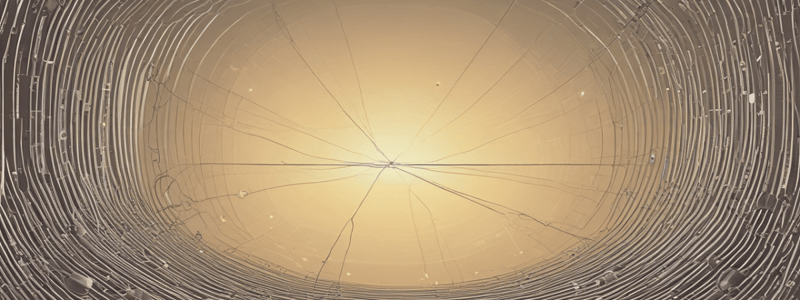Podcast
Questions and Answers
What is the fundamental principle behind Newton's third law of motion?
What is the fundamental principle behind Newton's third law of motion?
- For every action, there is an equal and opposite reaction (correct)
- Every action has a lesser opposite reaction
- Every action has a greater opposite reaction
- Every action has no opposite reaction
What is another name for Newton's third law of motion?
What is another name for Newton's third law of motion?
- The action-reaction law (correct)
- The force-motion law
- The motion-reaction law
- The equal-opposite law
What is the relationship between the action force and reaction force in Newton's third law of motion?
What is the relationship between the action force and reaction force in Newton's third law of motion?
- The action force is always greater than the reaction force
- The action force is always less than the reaction force
- The action force is always equal to the reaction force (correct)
- The action force is always opposite to the reaction force
Why do the action and reaction forces not cancel each other out?
Why do the action and reaction forces not cancel each other out?
What would happen if the equal and opposite forces were exerted on the same object?
What would happen if the equal and opposite forces were exerted on the same object?
What is the example of Newton's third law of motion mentioned in the passage?
What is the example of Newton's third law of motion mentioned in the passage?
What is the role of the person in the rowboat in the example of Newton's third law of motion?
What is the role of the person in the rowboat in the example of Newton's third law of motion?
What is necessary for the cancellation of motion to occur?
What is necessary for the cancellation of motion to occur?
What happens when the person in the rowboat exerts force on the water?
What happens when the person in the rowboat exerts force on the water?
Why does the rowboat move forward in the water but not on land?
Why does the rowboat move forward in the water but not on land?
How do rocket ships and fighter jets operate?
How do rocket ships and fighter jets operate?
What is the result of the action force of the engine and tires spinning on the ground?
What is the result of the action force of the engine and tires spinning on the ground?
What is an example of the application of Newton's third law of motion besides rocket ships?
What is an example of the application of Newton's third law of motion besides rocket ships?
What is the purpose of the induction generator in a water mill?
What is the purpose of the induction generator in a water mill?
Why does a person move forward when walking?
Why does a person move forward when walking?
Flashcards are hidden until you start studying
Study Notes
Newton's Third Law of Motion
- States that for every action, there is an equal and opposite reaction
- When one object exerts a force on a second object, the second object exerts a force on the first that is equal but opposite in direction
Examples of Newton's Third Law
- Rowboat: person exerts a force on the water using a paddle, and the water exerts a force on the rowboat and person
- Rocket ships: combustion of fuel creates an action force on the expanding gases, and the expanding gases exert an equal reaction force on the rocket ship
- Fighter jets: engine exerts an action force on the air, and the air exerts an equal reaction force on the fighter jet
- Cars: engine and tires exert an action force on the ground, and the ground exerts an equal reaction force on the car
- Bicycles: pedaling exerts an action force on the ground, and the ground exerts an equal reaction force on the bicycle
- Walking: muscles exert an action force on the ground, and the ground exerts an equal reaction force on the body
Key Points
- Action and reaction forces act on different objects
- Forces do not cancel each other out because they act on different objects
- If action and reaction forces act on the same object, they will cancel each other out
Applications of Newton's Third Law
- Rocket propulsion
- Fighter jet propulsion
- Conversion of motion into electricity (e.g. water mills)
- Everyday activities like walking, biking, and driving
Studying That Suits You
Use AI to generate personalized quizzes and flashcards to suit your learning preferences.




